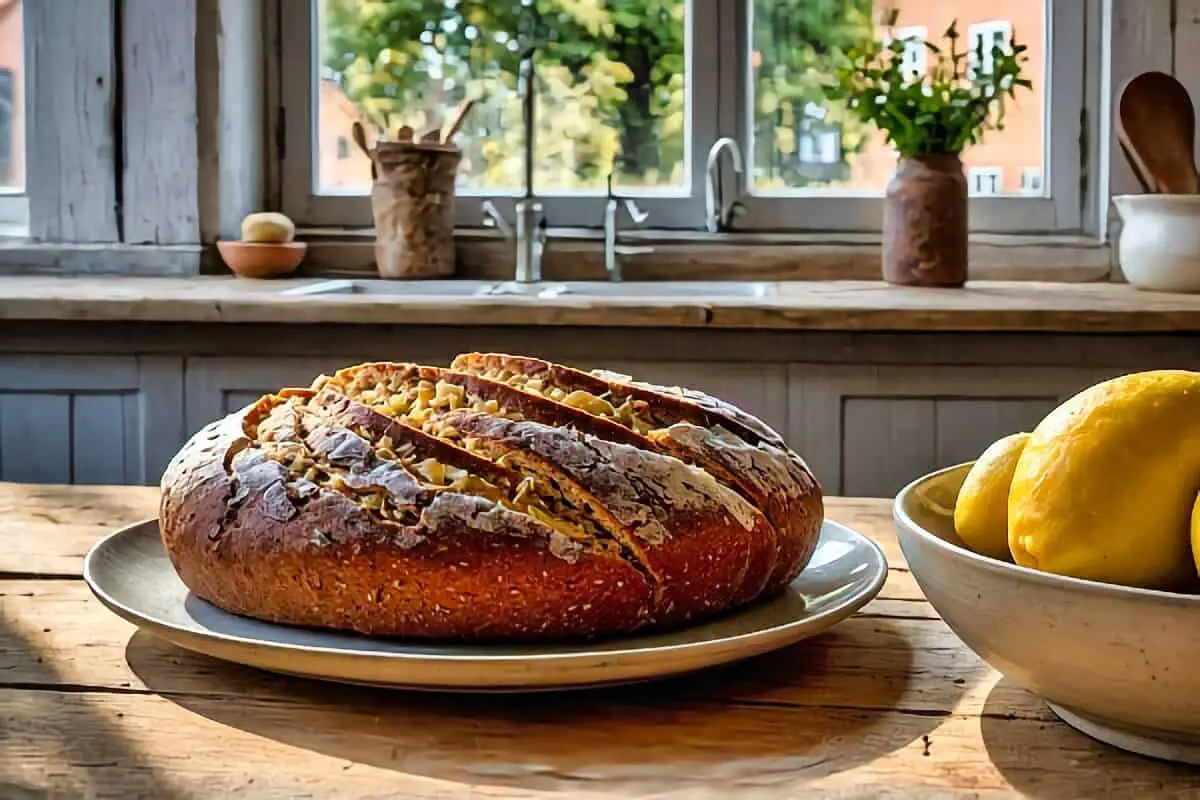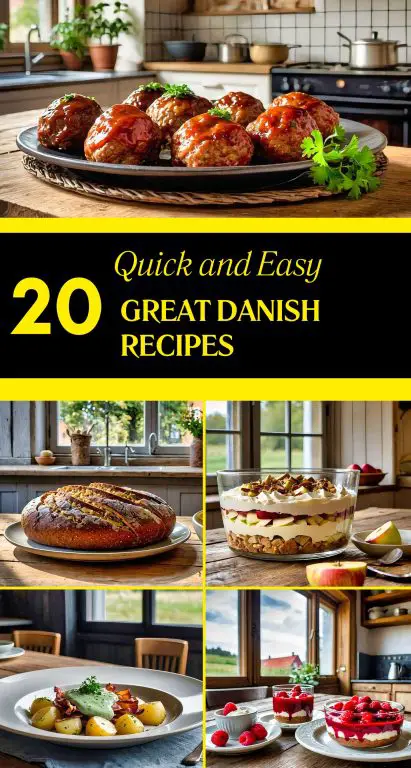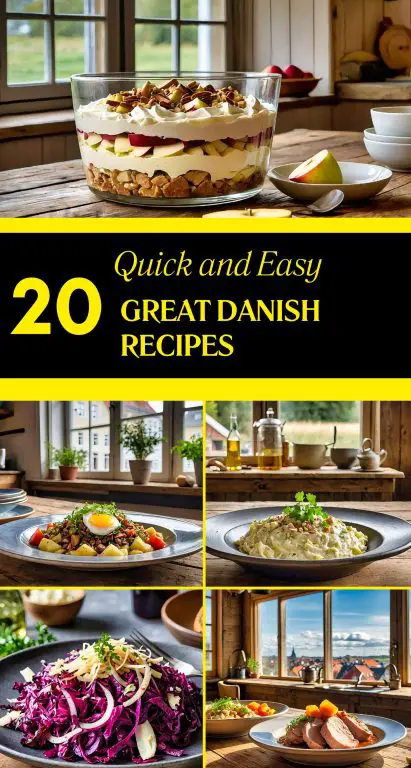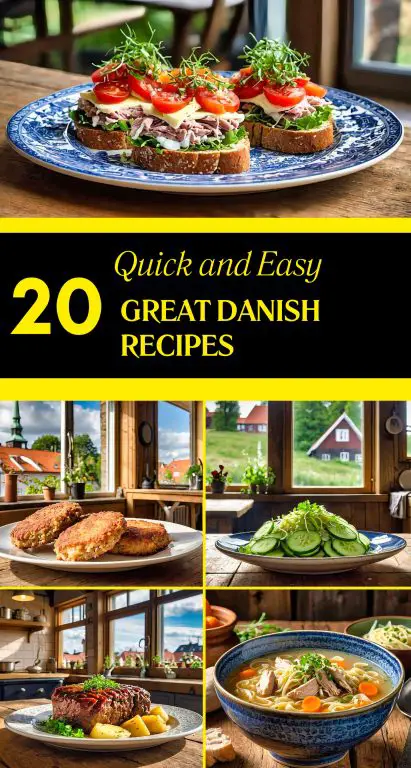The Danish Rugbrød recipe was the centrepiece of a cooking class I attended in Copenhagen, Denmark. Copenhagen is a vibrant city known for its blend of historic landmarks and modern design. Nyhavn, the picturesque waterfront district, features colourful buildings and boats along the canal, making it a must-see spot. Other key attractions include the Tivoli Gardens, an iconic amusement park, and the impressive Christiansborg Palace, home to the Danish Parliament. Walking through the city, cobblestone streets and stylish urban architecture provide a mix of charm and functionality.
The cooking class focused on making the Danish Rugbrød recipe, a traditional rye bread that is a staple in Denmark. Rugbrød is dark, dense, and often filled with grains and seeds. The instructor explained its cultural importance, highlighting that it serves as the base for popular dishes like Smørrebrød. The process involved mixing rye flour, whole grains, and sourdough starter, followed by a long fermentation period to develop the bread’s distinct flavour.
Making the Danish Rugbrød recipe required patience and attention to detail. The sourdough starter played a key role in achieving the bread’s tangy flavour and dense texture. During the class, I learned about the balance between hydration and baking time to create a loaf with a moist crumb and a firm crust. The final product was sliced thinly, as is traditional, and served with butter or as a foundation for open-faced sandwiches.
Tasting the Danish Rugbrød recipe, I noted its hearty texture and slightly sour taste. The bread was dense but not heavy, with a nutty flavour from the grains and seeds. It pairs well with both savoury and sweet toppings, making it versatile for various meals. The bread’s robust character explains its popularity among locals, as it complements many Danish dishes and provides a nutritious option for daily consumption.
Beyond the class, Copenhagen offered endless activities. The National Museum of Denmark provided insights into the country’s history, while the Round Tower offered panoramic views of the city. The city’s bike-friendly layout made it easy to explore areas like the trendy Nørrebro district or the serene Rosenborg Castle Gardens.
Learning the Danish Rugbrød recipe in Copenhagen added a practical and cultural dimension to my visit. The experience tied together the city’s culinary traditions and its reputation for combining history with modern living.
Ingredients
For the Liquid
Cereal Mix
Suflower Seeds
Pumpkin Seeds
Flax Seeds
Cold Water
For the Dough
Rye Flour
Bread Flour
Instant Dried Yeast
Cold Water
Salt
Mollasses
Butter
Cooking Instructions
- In a medium bowl, mix together all of the soaker ingredients. Wrap in plastic and set aside at room temperature for at least 8 to 12 hours, or overnight.
- In a separate basin, mix the yeast, water, and both types of flour to make the dough. The mixture will be thick, so stir it as best you can. Then, knead it for a short while with your hands until it comes together. The dough should be somewhat thick and have the consistency of clay. After 8 to 12 hours, cover with plastic and set aside to cool to room temperature.
- Butter a 13×4-inch pullman loaf pan and coat the inside and cover with rye flour. Put aside. Stand mixer bowl: combine soaker, flour mixture, salt, and molasses. Attach the paddle attachment to the mixer and mix on low speed for two to three minutes, scraping down the bowl edges occasionally, until everything is mixed. Turn the mixer up to medium and continue mixing for another two or three minutes, pausing every so often to scrape the bowl edges. The mixture has a tendency to stick.
- Put the dough in the pan that you had already greased. After you’ve leveled the top, sprinkle a little rye flour over the dough. Put the cover on the pan and leave it at room temperature for 1½ to 3 hours, or until the dough rises to a height of approximately ½ inch above the pan. The dough’s and your kitchen’s temperatures will determine how long it takes for the dough to rise.
- At the same time, set the oven temperature to 500 degrees. Put the lid on the oven and bake the loaf for 15 minutes. Bake, covered, for another 15 minutes after reducing heat to 400 degrees. Slid the lid off the pan carefully after taking it out of the oven. Bake, uncovered, for another 45 minutes after lowering the oven temperature to 325 degrees. Turn the loaf out onto a metal cooling rack placed inside a rimmed baking sheet as soon as you take it out of the oven.
- After 10 minutes, put the bread back in the oven. After taking the bread out of the oven, let it cool for at least three hours before slicing. After baking, rye bread tastes even better the next day. If you can, wait until the bread has cooled fully and then cover it loosely in foil and let it remain at room temperature overnight before slicing. Loosely wrapped bread will keep for three to five days at room temperature. For extended storage, freeze.
15 Essential Ingredients for Danish Cooking
Danish cooking revolves around fresh, seasonal ingredients that highlight the simplicity and natural flavours of Nordic cuisine. These essential ingredients are versatile and form the basis of many traditional Danish recipes. Here’s a closer look at the key components of Danish kitchens:
1. Rye Flour Rye flour is indispensable in Danish baking, especially for making rugbrød (rye bread). This dense, nutrient-rich bread serves as the foundation for many meals, including the iconic open-faced sandwiches, smørrebrød.
2. Potatoes Potatoes are a cornerstone of Danish cooking, featured in dishes like boiled potatoes, potato salads, and mashed potatoes. They are often served as a side with meat or fish.
3. Dill Dill is a popular herb in Danish cuisine, used to season fish, potatoes, and sauces. Its fresh, aromatic flavour is synonymous with Nordic cooking.
4. Cream Cream is a common ingredient in Danish dishes, adding richness to soups, sauces, and desserts like rice pudding (risalamande).
5. Pork Pork is the most commonly consumed meat in Denmark. It’s featured in recipes like flæskesteg (roast pork) and frikadeller (meatballs).
6. Pickled Vegetables
Pickled cucumbers, onions, and beets are used as condiments or sides, adding tanginess and crunch to meals.
7. Herring Herring, often pickled or smoked, is a staple ingredient in Danish cuisine. It’s a key component of traditional lunch platters.
8. Butter Danish butter, known for its high quality, is essential in cooking and baking, lending a rich flavour to dishes and pastries.
9. Onions Onions, both raw and cooked, are widely used in soups, stews, and salads. They provide a strong, savoury base for many recipes.
10. Eggs Eggs are a versatile ingredient, used in baking, sauces, and as a topping for smørrebrød.
11. Horseradish Horseradish adds a sharp, spicy flavour to sauces, seafood dishes, and garnishes, making it a must-have for Danish cooking.
12. Sugar Sugar is used to balance the acidity of pickled foods, as well as in desserts and baked goods like Danish pastries (wienerbrød).
13. Bay Leaves Bay leaves are used to add depth to soups, stews, and marinades, giving a subtle herbal aroma to many traditional dishes.
14. Fish In addition to herring, other fish like cod and plaice are widely used in Danish cooking, often prepared pan-fried or smoked.
15. Cheese Cheese, particularly creamy and aged varieties, plays a role in Danish cuisine, both as a topping for bread and as part of a meal.
These 15 ingredients form the essence of Danish cooking, reflecting the country’s commitment to fresh, simple, and flavourful food. From the richness of cream and butter to the tang of pickled vegetables, each ingredient contributes to the unique character of Nordic dishes.
How to Find Local Food Favorites in Denmark
Copenhagen, Denmark’s vibrant capital, is a hub for culinary exploration, blending traditional Nordic dishes with modern food trends. For visitors looking to experience the best local food spots, the key lies in seeking out places that prioritise fresh, seasonal ingredients and authentic Danish flavours. While the city offers numerous high-end restaurants, including several Michelin-starred establishments, some of the most memorable dining experiences can be found at more casual and locally loved spots.
One of the best ways to uncover Copenhagen’s food gems is by exploring the city’s bustling food markets. Torvehallerne, an indoor food market located in the heart of Copenhagen, is a treasure trove of Danish delicacies. Here, you’ll find vendors selling everything from traditional smørrebrød (open-faced sandwiches) to freshly baked pastries like kanelsnegle. For a truly local experience, try sampling fresh fish or locally crafted cheeses. These markets also provide the opportunity to interact with the vendors, who often have great recommendations for nearby hidden gems.
Walking through the city’s diverse neighbourhoods is another effective way to find authentic food experiences. Nørrebro, known for its multicultural flair, offers a range of eateries serving both traditional Danish fare and creative fusion cuisine. Meanwhile, the Christianshavn neighbourhood boasts charming canalside cafes where you can enjoy classic dishes like frikadeller (Danish meatballs) or flæskesteg (roast pork with crackling).
If you prefer guided insights, consider joining a local food tour. Many tours in Copenhagen focus on showcasing the city’s culinary highlights, often including visits to lesser-known spots that tourists might overlook. These tours are an excellent way to sample a variety of Danish foods while learning about their history and significance.
Social media and review platforms like Instagram and TripAdvisor can also point you toward popular local favourites. Look for posts and reviews from locals rather than tourists to get authentic recommendations. Many Copenhagen residents share their dining experiences online, making it easier to discover hidden treasures off the beaten path.
Don’t overlook Copenhagen’s bakeries and coffee shops, which are an integral part of Danish food culture. Iconic pastries like wienerbrød (Danish pastries) are best enjoyed fresh from a neighbourhood bakery. Pairing a pastry with a cup of strong Danish coffee at a cosy cafe offers a quintessentially Danish experience.
Last, be open to asking locals for advice. Danes are known for their friendliness and will often be happy to share their favourite dining spots. Whether it’s a bartender at a craft beer bar or the cashier at a local market, their recommendations can lead you to some of the most authentic meals in Copenhagen.
By combining market exploration, neighbourhood walks, guided tours, and local advice, you can immerse yourself in Copenhagen’s vibrant food scene. These efforts not only ensure you’ll find the best local food spots but also deepen your understanding and appreciation of Danish cuisine.
FAQ For the Danish Rugbrød Recipe
Q: What is the Danish Rugbrød recipe?
The Danish Rugbrød recipe is a traditional rye bread made with rye flour, whole grains, and a sourdough starter. It is dense, hearty, and often includes seeds, making it a staple in Danish cuisine and commonly used for open-faced sandwiches like Smørrebrød.
Q: What ingredients are required for the Danish Rugbrød recipe?
The Danish Rugbrød recipe typically includes rye flour, whole grains such as cracked rye or sunflower seeds, a sourdough starter, water, and salt. Some variations may include sweeteners like molasses or honey.
Q: How do you prepare the Danish Rugbrød recipe?
To prepare the Danish Rugbrød recipe, mix the ingredients into a thick dough and allow it to ferment with the sourdough starter for several hours or overnight. Once fermented, the dough is baked at a low temperature to develop a firm crust and a moist interior.
Q: Why is the Danish Rugbrød recipe popular in Denmark?
The Danish Rugbrød recipe is popular in Denmark because of its nutritional value, versatility, and cultural significance. Its dense texture and tangy flavour make it an ideal base for various traditional dishes, including Smørrebrød, and it is a staple in Danish households.
Q: Can the Danish Rugbrød recipe be adapted for dietary preferences?
Yes, the Danish Rugbrød recipe can be adapted to suit dietary preferences. For example, gluten-free variations can be made using alternative flours and grains. However, the traditional recipe relies on rye flour and sourdough for its characteristic texture and flavour.

Danish Rugbrød Recipe
Ingredients
For the Liquid
- 2 ½ cups cereal mix 7 grain hot
- 1 cup sunflower seeds
- 1 cup pumpkin seeds
- ½ cup flax seeds
- 2 ⅔ cups water cold
For the Dough
- 2 cups flour dark rye-I use the Bob’s Red Mill brand, plus more for dusting the pan and loaf
- 2 cups flour for bread
- 1 tsp yeast instant dried yeast variety
- 1 ½ cups water cold
- 4 teaspoons salt
- ¼ cup molasses
- Butter for greasing the pan
Instructions
- In a medium bowl, mix together all of the soaker ingredients. Wrap in plastic and set aside at room temperature for at least 8 to 12 hours, or overnight.
- In a separate basin, mix the yeast, water, and both types of flour to make the dough. The mixture will be thick, so stir it as best you can. Then, knead it for a short while with your hands until it comes together. The dough should be somewhat thick and have the consistency of clay. After 8 to 12 hours, cover with plastic and set aside to cool to room temperature.
- Butter a 13x4-inch pullman loaf pan and coat the inside and cover with rye flour. Put aside. Stand mixer bowl: combine soaker, flour mixture, salt, and molasses. Attach the paddle attachment to the mixer and mix on low speed for two to three minutes, scraping down the bowl edges occasionally, until everything is mixed. Turn the mixer up to medium and continue mixing for another two or three minutes, pausing every so often to scrape the bowl edges. The mixture has a tendency to stick.
- Put the dough in the pan that you had already greased. After you've leveled the top, sprinkle a little rye flour over the dough. Put the cover on the pan and leave it at room temperature for 1½ to 3 hours, or until the dough rises to a height of approximately ½ inch above the pan. The dough's and your kitchen's temperatures will determine how long it takes for the dough to rise.
- At the same time, set the oven temperature to 500 degrees. Put the lid on the oven and bake the loaf for 15 minutes. Bake, covered, for another 15 minutes after reducing heat to 400 degrees. Slid the lid off the pan carefully after taking it out of the oven. Bake, uncovered, for another 45 minutes after lowering the oven temperature to 325 degrees. Turn the loaf out onto a metal cooling rack placed inside a rimmed baking sheet as soon as you take it out of the oven.
- After 10 minutes, put the bread back in the oven. After taking the bread out of the oven, let it cool for at least three hours before slicing. After baking, rye bread tastes even better the next day. If you can, wait until the bread has cooled fully and then cover it loosely in foil and let it remain at room temperature overnight before slicing. Loosely wrapped bread will keep for three to five days at room temperature. For extended storage, freeze.





1 comment
Best Rye bread that I ever tried.